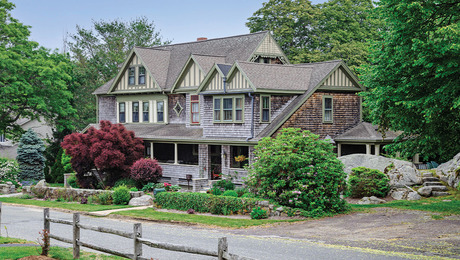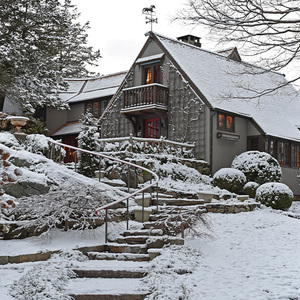We are currently building our own 5,500 sq. ft. custom home. We have full 2 x 6 stud walls with 1″ hardboard insulation, wrapped with commercial Tyvek and 1″ thick board and batten hemlock wood siding. We are slab on grade with a combination radiant floor heat system and forced air heat exchanger fired from a wood boiler (dual purpose duct work for air conditioning). The entire electrical system is in conduit. We live in a cold northern climate. Our current dilemma is regarding the insulation. Originally, we constructed the house to allow for full fiberglass insulation in the walls. During our research, we found an open cell foam insulation product trademarked as Icynene. The problem is that we cannot find independent confirmation / comparison to determine that this is really the route that we want to go. My concerns include the Icynene cost (approximately $12 – 15,000 to completely insulate the home) and long-term issues about the potential chemical reactions, mold/moisture/rot problems, etc. What is attractive about the product is the ability to completely fill the voids around the conduit and around the ends of the floor trusses. We have included an outside air system for circulation due to the tightness of the proposed insulation. We expect to be in this home for many, many years and I don’t want to be short-sighted on something that you only get one shot at. So anyone with experience or insight on this dilemma would be great appreciated.
Discussion Forum
Discussion Forum
Up Next
Video Shorts
Featured Story

From plumbing failures to environmental near disasters, OHJ staffers dish on our worst and best moments.
Featured Video
How to Install Cable Rail Around Wood-Post CornersHighlights
"I have learned so much thanks to the searchable articles on the FHB website. I can confidently say that I expect to be a life-long subscriber." - M.K.














Replies
You migh try searching the archives, to see what turns up regarding icynene - It's been discussed several times.
You would also get some more specific responses if you tell us where you're located. Icynene might make more sense in ALaska than Alabama.
Just to confuse the mix a bit - Have you looked at wet blown in fiberglass or celulose?
There is no freshness date on software. Bits do not spontaneously decay.
Thanks for the response! I'm new to the website, although we've subscribed to the magazine for a couple of years. I tried researching the magazine site for past articles, but no luck. Not sure how to research the Breaktime archives, but I'll make that a new mission.
We live in northern Pennsylvania - just far enough off the lake to be the lucky recipients of the "lake effect snows". We looked at the cellulose application and did not like the mold/mildew potential as well as the perceived potential for settling. I rather liked the blown in fiberglass concept - we received a quote of about $5,000 to do the house. Of course the argument against fiberglass is still air infiltration - the whole point behind insulating. I talked to a Certainteed representative about their "Optima" virgin fiberglass dry installation with a mesh barrier - but have not been able to find an installer in our area for a quote.
When I said "search the archives", I didn't mean on the magazine's website.
Look to the upper left of this message. You should see the text "Advanced Search". Click on that, and try entering "icynene" or "insulation" in the search box. That should get ya all kinds of hits.
For what it's worth, I used blown in fiberglass in a house I recently built, and was quite impressed with it. I also like the idea of icynene. But there are no local installers and it's awfully expensive.Those who can, do. Those who can't, get patents.
You really can't compare the two. Apples and oranges.
Instead of the icynene we use mainly PUR because it's closed cel and gives a better VB rating.
Yes the cost is greater but so is the return.
Gabe
You sound like a guy that is doing some of his own work. How about a combination of insulations. Fiberglass works well if there is no air infiltration. You could foam to a depth of 2 inches yourself, thus sealing any holes or air passages and then have wet fiberglass blown in to fill the cavity. Go to http://www.fomo.com and look for their two part urethane foam. You can foam what you need to foam yourself and be sure that the walls are sealed, then let the contractor blow the fiberlass.
Foaming isn't for the DIYs if you want it done right. Add another inch to your foam equation and you don't need any FG. Never mix apples and oranges unless you're a trained chef.........in other words don't give advise unless you know what you're taking about.
Two and a half inch minimum of PUR will keep any house in Penn. warm and cosy.
Gabe
Also, do some research on Corbond.
I used Icy in my roof and gable ends it has worked great so far.
My thought there was that most people feel the need to fill up the stud bays. He built the house with 2x6s to be able to stuff more insulation into the walls. I agree with you that 3 inches of PUF would do a great job but I still don't see the problem with mixing the two insulations. Why does it matter how you achieve a stud or rafter bay that does not allow air infiltration? Once you achieve that, any insulation will be effictive.
If your thinking is in FG or Celulose then fill the cavity is the common objective.
However, if sealing with PUR, it's not required to fill the cavity.
We have been brainwashed with this need to fill the cavity and to get more thermal resistance we make the cavity bigger and then we can have bigger cavities to fill.
Think about this...
We build homes with R16 walls, R32 ceilings or roofs and then we install R3 windows and then we make sure that we build in enough nook and crannies to ensure air leaking all over the place.
If you control the air infiltration and exfiltration you control the temperature as well.
Gabe
I used Iso open cell foam on my house. 2000 sf, 2x6 walls. It cost about $6k and was a $1000 over the fiberglass bid. So far so good, Went on quick and definitely fills every little nook and cranny. Pretty impressive.
This is an enveloped system, simple tar paper and no tyvek on the outside and the roof is not vented. I did this on the Northern Oregon Coast, probably the most wet and windy climate in the world.
GoSo